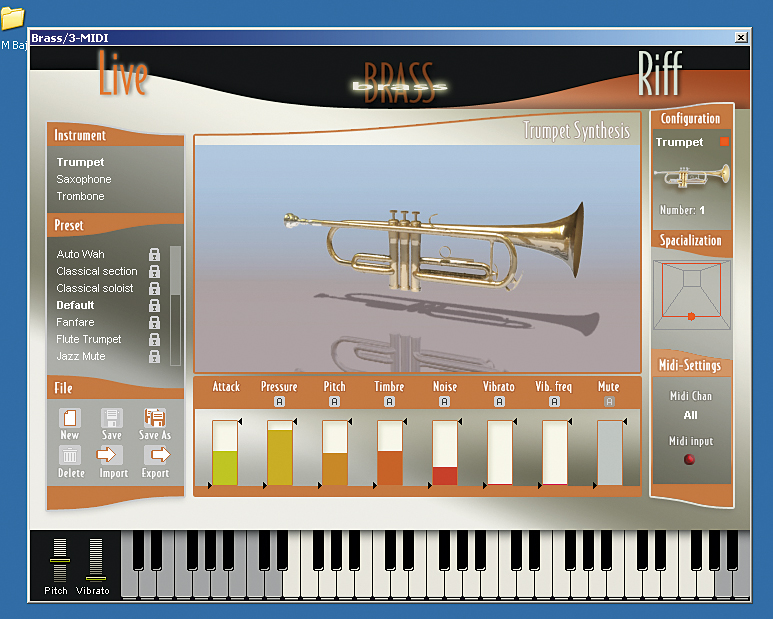MusicRadar Verdict
Brass promised a lot, but sadly, it delivers very little. We just don't think it sounds realistic enough.
Pros
- +
Easy to set up… …and use.
Cons
- -
Doesn't sound realistic. Only three instruments available (though there are variations within these). High price. A learning curve if you want to program your own instruments. Polyphonic programming is a bit tedious.
MusicRadar's got your back
Well, they certainly kept us waiting. We're all for software houses taking the time to get things right - rather than releasing products too early and then expecting the pioneer purchasers do the bug-finding - but Arturia kept Brass under wraps for months.
However, they finally seem to be satisfied with the software and it's on the shelves. If it does what it promises, a new era of computer-only brass and sax sections will be inaugurated, and quite a few players of the blowing variety could be heading down to their local job centre.
Brass comes in a sturdy if slightly unnecessarily large box that contains the software on CD, a printed manual and a Syncrosoft USB dongle.
In the commercial product, the security system is supposed to work straight out of the box, but our review copy needed internet authorisation and was something of a hassle to get going. However, both Arturia and Syncrosoft were very supportive.
If you already have a Syncrosoft key (eg, for Cubase) the licence for Brass can be stored on this, meaning you won't need to use up another USB port. The CD installs both Brass and the protection software without a hitch - just follow the instructions.
Overview
Brass's two windows, Live and Riff, are styled in a restrained black, brown and silver colour scheme. Both feature a virtual keyboard - this is playable and also reflects the notes played on your MIDI keyboard.
A range of presets is instantly available for use in the Live window - you choose Trumpet, Saxophone or Trombone and then select from 17 variations. These include Auto Wah, Classical and Jazz Section, and there's also a range of mutes for trumpet and trombone.
When played without accompaniment, the presets are, without exception, disappointingly unreal. There's a 'blip' attack on every note (except those played legato - in Live mode, Brass is monophonic) and it's impossible to shift.
Arturia say that this isn't a bug of any sort, but we certainly heard it. This 'blip' is followed by a rather stylised 'falling back' and then surge in volume.
For real-world brass players, this would almost amount to an fp crescendo dynamic marking on every non-legato note. Annoying.
The aforementioned attack is skipped for legato notes, but the result is a fairly bland flow of anonymous pitches.
The section presets, meanwhile, sound like the solo sounds with a chorus effect added, and this merely adds another layer of unreality.
The connecting of notes into a smooth melodic line is certainly incredibly difficult to mimic digitally, but the fact remains that it's characteristic of all brass, wind and bowed instruments.
Given that Brass is being sold on the strength of its ability to recreate real-world instruments, this should have been a rather important consideration - the only significant consideration, perhaps.
To play polyphonically you have two choices: either set up instances of Brass for as many voices as you need on individual tracks in your sequencer, or switch to the Riff window.
Phrase sequencer
This contains its own little phrase sequencer, which can sync to the host's tempo. In this case, you have to create each phrase as a MIDI clip and import it into Brass's riff library - you can't just play chords on the keyboard.
Brass also comes with a selection of ready-made MIDI riffs in a variety of styles and instrumentations (up to four parts). The riffs are triggered from a single note on your MIDI keyboard or from a single note on a sequencer track. You can change the key of the riff by holding down different notes on the upper part of the keyboard.
Because they're stored as MIDI data, the notes in the riffs can be freely edited - they're not immutable audio recordings. These edited riffs can be saved and added to the library.
It's a shame we have to be negative about Brass - a lot of detailed work has clearly gone into it, and it's pretty easy to use. However, the sound you get from it is what counts, and this leaves a lot to be desired.
It simply lacks realism, and if Brass doesn't make a realistic sound then the whole point of the exercise is missed.
Maybe one day virtual modelling software will be so cunning that the listener will be fooled into thinking that real-world instruments are being used, but sadly, that day has not yet come. Brass and sax players can relax - we still need you.
Computer Music magazine is the world’s best selling publication dedicated solely to making great music with your Mac or PC computer. Each issue it brings its lucky readers the best in cutting-edge tutorials, need-to-know, expert software reviews and even all the tools you actually need to make great music today, courtesy of our legendary CM Plugin Suite.

“Almost a lifetime ago, a few Burnage lads got together and created something special. Something that time can’t out date”: Original Oasis drummer Tony McCarroll pens a wistful message out to his old bandmates

“A high-quality solution for capturing your drums”: Sennheiser MD 421 Kompakt review

“I need to build a sound of my own that has the power that I want”: Floating Points hates festival sound systems so much that he’s invented his own










